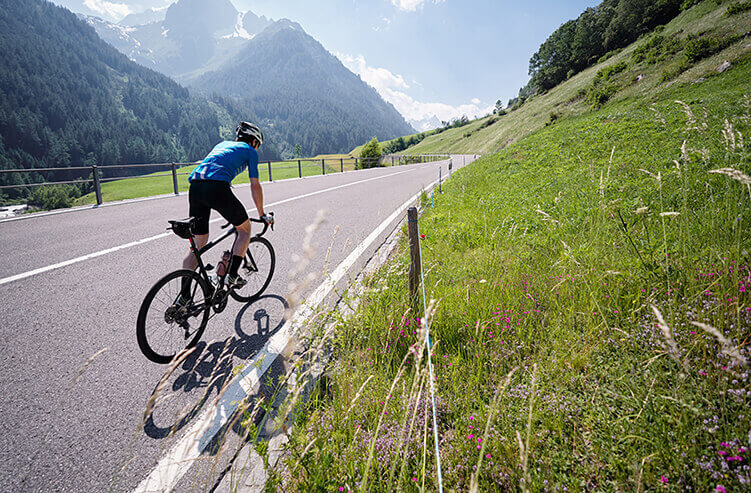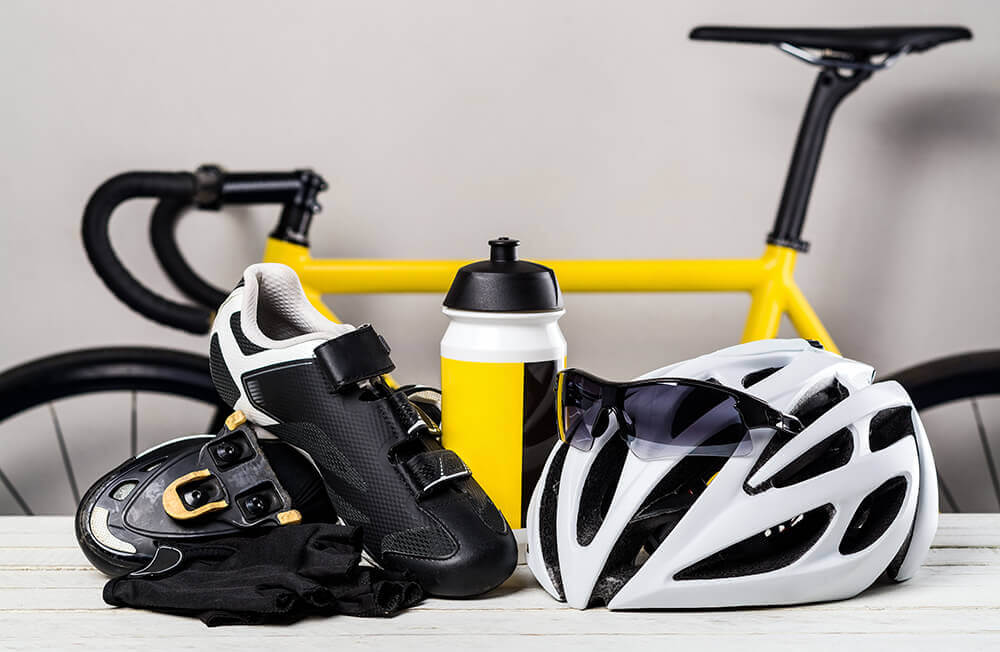Are you ready to conquer those daunting hills on your next cycling adventure? Bike hill climbs can be both challenging and exhilarating, testing your strength, endurance, and mental fortitude. In this blog post, we’ll guide you through mastering hill climbs, choosing the right road bike, perfecting your body positioning and pedaling cadence, and more. So gear up and let’s dive into the world of bike hill climbs like a true pro!
Key Takeaways
- Climb hills like a pro with the essential skills for bike hill climbs - maximize fitness, strength and performance!
- Master body positioning & technique.
- Train with interval & strength exercises, stay safe on descents & use visualisation techniques to reach peak performance!
Mastering Bike Hill Climbs

Hill climbing is an essential skill for any cyclist, as it helps develop strength, endurance, and overall cycling abilities. Hill climb racing can be a fun and challenging way to improve your cycling prowess during the hill climb season.
Maximizing the energy you expend will significantly boost your power during road bike hill climbs.
Importance of hill climbing
Hill climbing offers significant benefits for fitness, strength, and cycling performance, especially when tackling steep climbs. Staying seated allows you to make the most of your glutes and thighs during the pedaling phases, helping you stay in the aerobic zone and avoid entering the anaerobic zone.
Conversely, climbing while standing out of the saddle quickly increases power and engages more upper body muscles.
Types of hill climbs
There are various thrilling types of hill climbs, such as short and steep, long and gradual, and variable gradients. For short and steep hill climbs, using a higher cadence and lower gear is the perfect way to maintain a steady power output.
For long, gradual climbs, challenge yourself to ride at your threshold power, similar to a one-hour time trial.
For variable gradient hill climbs, anticipating gradient changes and adjusting your cadence and gearing accordingly is the key to success.
Choosing the Right Road Bike for Hill Climbing

Selecting the perfect complete bike for road bike climbing will significantly enhance your riding experience, enjoyment, and speed while providing a comfortable fit for the task.
A hill climbing bike with a lightweight frame, aero handlebars, a lightweight chainset, lightweight wheels, and electronic shifters will significantly ease your uphill journey.
Key features to consider
When choosing a hill climbing bike, consider factors like:
- Bike weight: A lighter bike will help you accelerate and climb hills with ease
- Frame material: Materials like aluminum, carbon fiber, and titanium provide strength and lightweight properties
- Gearing: Opt for a bike with a wide range of gears to tackle different gradients.
By considering these factors, you can find a bike that is well-suited for hill climbing.
Moreover, it’s worth considering your bike’s gear ratios since the appropriate combination can greatly enhance your hill climbing performance.
You should also consider a phone mount that will wireless charge your phone to take on your rides. You don't want to be on a ride and have your phone battery die. A secure handlebar mount and phone charging case is the perfect addition to your ride.
Body Positioning and Technique

Optimal body position and technique can greatly enhance power output and efficiency during uphill cycling. Sustaining upper body control and preserving energy during hill climbs are vital steps towards minimizing fatigue and maximizing performance.
Seated vs. standing
Seated climbing offers the benefit of energy conservation, while standing climbing provides more power but can be less efficient. Lighter riders tend to excel when climbing out of the saddle.
For long gradual hills, remaining seated in the saddle is the most effective way to tackle the climb.
Upper body control
Maintaining upper body control during hill climbs can help you conserve energy while climbing hills, making your climb more efficient. To maintain upper body control and conserve energy while conquering hill climbs, follow these tips.
- Keep your upper body relaxed and stable.
- Use your core muscles to maintain stability.
- Keep your hands light on the handlebars, avoiding gripping too tightly.
- Focus on maintaining a smooth pedal stroke and a steady rhythm. By following these tips, you’ll be able to power through hill climbs with ease.
Keeping a relaxed stance for the upper body during hill climbs can help you breathe more comfortably by relieving pressure from the diaphragm and lungs.
Perfecting Your Pedaling Cadence
Maintaining cadence becomes challenging during hill climbs as the gradient steepens. Identifying and sustaining an optimal cadence aids in preserving energy and momentum during hill climbs, thereby easing and enhancing the efficiency of the climb.
It is important to remember that cadence is not the only factor when it comes to hilly terrain.
Finding your optimal cadence
The most efficient cadence for hill climbing is between 70 to 90 revolutions per minute, so you can get to the top of the hill with the least amount of effort.
Experiment and observe how your body responds to determine the best cadence that fits your individual climbing style and fitness level.
Adjusting cadence for different hills
When climbing uphill, it is recommended to increase your cadence to maintain momentum, stay energized, and prevent muscle fatigue.
When descending, you can lower your cadence to confidently control your speed and maintain stability for an enjoyable ride. Explore different cadences and gear ratios to discover what works best for you on different kinds of hills.
Gearing and Shifting Strategies
A common mistake while climbing hills involves hesitation to downshift, leading to either tackling the hill in an overly high gear or lacking sufficient gears for selection.
Proactive gear shifting and anticipation of gradient changes can greatly enhance your gear shifting efficiency during hill climbs.
Anticipating gradient changes
Staying ahead of gradient changes when biking hill climbing is crucial for success. Spot the road veering up? Quickly lower your gear and start pedaling faster. Increase your cadence to get moving with ease.
It’s always best to change gears in sufficient time, especially when the road is steep. Otherwise, it can be very hard or even impossible to switch gears.
Avoiding cross-chaining
Cross-chaining can lead to accelerated wear on your bike’s drivetrain and can hinder your efficiency while climbing hills. To help you stay away from cross-chaining, you can:
- Shift both sides of the drivetrain simultaneously
- Downshift two gears at once in the rear
- Steer clear of gear combinations that could bend the chain
- Adjust the front derailleur to ensure it’s properly aligned
- Optimize your gear ratios based on your speed and the terrain.
To avoid cross-chaining, you should shift both sides of the drivetrain simultaneously, down the road.
Mental Approach to Hill Climbing
A successful mental strategy for hill climbing includes:
- Challenging oneself to remain seated or standing longer as needed, providing a rewarding experience
- Self-pacing
- Visualization
- Goal setting
These strategies can keep you energized and motivated during a hill climb.
Visualization can help you focus on the task at hand and break the climb into manageable chunks.
Pacing yourself
Finding the most effective pacing for hill climbing can be a great way to optimize your performance on a chosen hill. Experiment with different strategies and compare power and timings to identify the best approach.
Additionally, breaking longer climbs into smaller sections and completing each section with the right intensity can be very beneficial.
Visualization and goal-setting
Visualization and goal-setting can help you stay motivated and focused on the desired outcome, enabling you to make the most of your hill climbing performance. Visualizing yourself reaching the top of the hill can help you stay inspired and keep pushing forward.
Setting goals can also help you stay motivated and focused, as you can track your progress and strive to achieve your goals.
Training Tips for Improved Hill Climbing Performance
Integrating specific hill-training into your cycling routine can significantly enhance your hill climbing performance. Interval training can help boost your power, speed, and endurance - all essential for successful hill climbing.
Strength and core workouts can also help by increasing your power and endurance for hill climbing, giving you an extra edge on the hills.
Interval training
Interval training offers numerous benefits for hill climbing, such as improved power, speed, and endurance.
Sustained power intervals, surge power intervals, attacking power intervals, flat sprinting (for advanced runners), hill running, climbing intervals of varying durations, and weight-bearing activities like trail running, hiking, or snowshoeing are all great interval training workouts to help improve your hill climbing abilities.
Strength and core workouts
Strength and core exercises play a crucial role in improving hill climbing performance. Here are some excellent exercises to target the core muscles and strengthen stability, balance, and overall strength for hill climbing.
- Planks
- Hanging leg raises
- Side plank with front leg raise
- High plank with a knee to opposite elbow
- The Bird Dog
- Reach, roll, lift
These exercises can be done at home or in the gym, and can be tailored to the individual.
Safety Tips for Descending Hills
Descending hills can pose a challenge equivalent to the climb itself. Preserving a manageable speed for easy bike control is paramount for safety, and using Vittoria Corsa Speed tyres can help achieve that.
Riding too fast downhill can make it harder to control the bike and can be dangerous.
Body positioning
During downhill descents, remember to:
- Lower your chest and hips for maximum traction and stability
- Keep your chin over your stem to maintain balanced weight distribution
- Keep your knees and elbows bent to stay agile and ready to tackle the terrain
Braking techniques
Effective braking is essential for maintaining control and safety while descending hills. Apply the brakes evenly and gradually for maximum effectiveness, and anticipate the terrain ahead to plan your braking accordingly. One great option for reliable stopping power is the cane creek ee brakes.
Use the correct braking technique for the terrain you are riding on to ensure maximum safety.
Summary
Conquering hills on your bike is a rewarding and exhilarating challenge that can push your limits and help you grow as a cyclist. With the right bike, proper body positioning, effective pedaling cadence, and mental preparation, you’ll be well on your way to climbing hills like a pro. So gear up, embrace the challenge, and let the journey begin!
Frequently Asked Questions
Why do I struggle cycling uphill?
Trying to tackle a hill in the wrong gear or without enough gears can make cycling uphill difficult. Anticipating and lowering your gear before the gradient increases, then spinning at a higher cadence can help you maintain momentum on a climb.
How do you hill climb on a bike?
To hill climb on a bike, shift into an easier gear before your cadence slows and get a bit of momentum. Use a consistent cadence, rock the bike gently from side to side when out of the saddle and take corners wide when possible.
What rpm range for hill climbs?
For hill climbing, the most common advice is to range from 65 to 90 rpm, so you can find which cadence is more efficient for you.
How can I maintain control and safety while descending hills?
Stay safe while descending hills by controlling your speed, positioning your body correctly, and applying the right braking technique.
What are the key features to consider when choosing a hill climbing bike?
When choosing a hill climbing bike, prioritize a lightweight frame and components, such as aero handlebars, a lightweight chainset, lightweight wheels, and electronic shifters, for an optimized ride experience.




Leave a comment
This site is protected by hCaptcha and the hCaptcha Privacy Policy and Terms of Service apply.